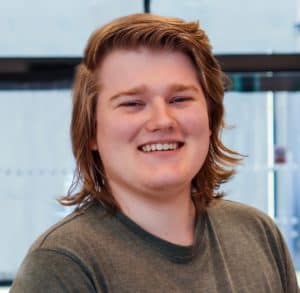Johannes Andersen taught himself programming as a hobby — but he didn’t seek out software development jobs because he didn’t want something he enjoyed to turn into a chore.
Instead, he worked in customer service for a financial services firm in Belfast, Northern Ireland. His favorite part of that job was helping stop fraud, though it was frustrating because people usually called customer service too late after they had sent money to scammers.
Andersen heard about a risk analyst position at Signifyd, where he would be focused on fraud prevention. He jumped at the chance, joining in September 2019. Today, he is a front-end software engineer.

Johannes Andersen
At Signifyd, moving from one team to another is not only possible – in Andersen’s case, his managers suggested it.
Andersen’s job as a risk analyst involved looking at the small percentage of online orders that Signifyd’s machine learning system had flagged as high risk or couldn’t validate. He’d verify whether the orders were legitimate. Risk analysts also look for trends or review patterns for specific customers.
“We get a lot of fraud trends,” Andersen says. A recent example: “tricking elderly people into thinking they’re in love.” Scammers prey on lonely seniors on dating sites, establishing a relationship and ultimately inventing a story about needing money or products available online to get out of a crisis. Risk analysts help define and catch new and growing trends to help the model improve to meet the challenges of the changing fraud scene.
Internal users benefit from a detailed interface
As a risk analyst, Andersen dealt with a lot of data: seller information, buyer information, discount codes, purchase amounts, and how long users spent on each web page. Not everything the analysts needed to see was displayed in their user interface – or if it was, it wasn’t always in a useful format. For example, it’s useful for risk analysts to see how long a user stayed on a page while making a purchase. If the purchase is fraudulent and was done by a bot, it may happen in just milliseconds.
However, the review interface did not show the information directly. It was hidden in JSON code in a separate tab, which made the numbers difficult to grasp quickly. To make matters worse, the times were all reported in milliseconds, which made the numbers difficult to grasp quickly.
“The human brain doesn’t convert milliseconds to minutes easily,” Andersen said.
The team requested upgrades to their interface from engineering – the same engineering team Andersen has now joined – but because that team also works on customer-facing tools, their requests sometimes took time to fill.
So Andersen put his programming skills to work, creating a private Chrome extension that converted milliseconds into minutes and seconds and displayed the time-on-site information on the main console, making it easier for the analysts to quickly spot unusual transactions or patterns.
Software developer, heal thyself
“After work, I created tools to automate the risk analyst job I was doing day to day,” Andersen says. “I created UIs and buttons to make it a bit easier to get data.”
His managers noticed his interest in — and aptitude for — programming. They asked him about his career goals.
This is a common conversation at Signifyd, where all managers are given tools to help employees create development plans, says Annie Eller, senior HR business partner. “These include creating a leveling, or career ladder, showing the path for growth and then talking with employees about their career goals,” she says. “If an employee is interested in a career path in another department, we encourage the employee to talk with the manager from that other department to understand that department’s career path and what skills are needed to develop into that role.”
When Andersen’s managers asked him about his goals, he did not immediately say he wanted to join the engineering team. He didn’t have a clear career path mapped out for himself — he had worked in retail before getting the job in customer support. From there he moved to Signifyd.
“I’d been programming for years, but I never wanted to do it as my job,” he says. “So I said I wanted to go into data science.”
His managers had seen his programming skills, though, and they thought he would make a good member of the front-end engineering team. They made him an offer: Try working on the front-end software engineering team for three months. If he didn’t like it, they would help him move to the data science team.
Working with managers leads to a new opportunity
So in January 2020, he joined the front-end engineering team on a temporary assignment, working on the customer console that users see when they log in, as well as on tools used internally. By April, it was clear that he wanted to make the move. So, he joined the team and began work on a training program that he and his manager designed to ensure he’d have the skills and resources he needed to be successful.
The program included quarterly goals, such as joining the pager schedule to be on call for emergencies or helping onboard a new employee. He had one-on-one meetings with his manager and his group’s principal software engineer to go over his progress.
Andersen enjoyed the work so much that he completed three years’ worth of goals ahead of schedule, and in January 2021, he was promoted to a full-fledged software engineer. He is continuing to work toward his Amazon Web Services certification, which the company pays for.
“When you know the basics of programming, you can learn pretty much anything else,” Andersen says. “You just need the general mindset of expanding on your knowledge.”
Another key to his successful move: being willing to try a position that the company needed to fill. “We had a lack of front-end engineers,” Andersen says.
Moving to a new team is very possible for Signifyd employees, and “hunger on the part of the employee to understand what they want and to go for it” is one of the key ingredients, says Emily Mikailli, senior vice president of people operations. It’s great for employees to talk to their managers about their goals, but it’s also OK for employees to start working toward a new goal on their own. “Sometimes people want to explore things without looping in their manager first.”
Andersen says he is now working toward his next promotion, to senior software engineer. Working on the engineering team has also given him new ideas for long-term career goals: In a few years, he’d like to move into engineering management.
Photo by Philippe Jausions on Unsplash
Looking for an organization that believes in growing together?







